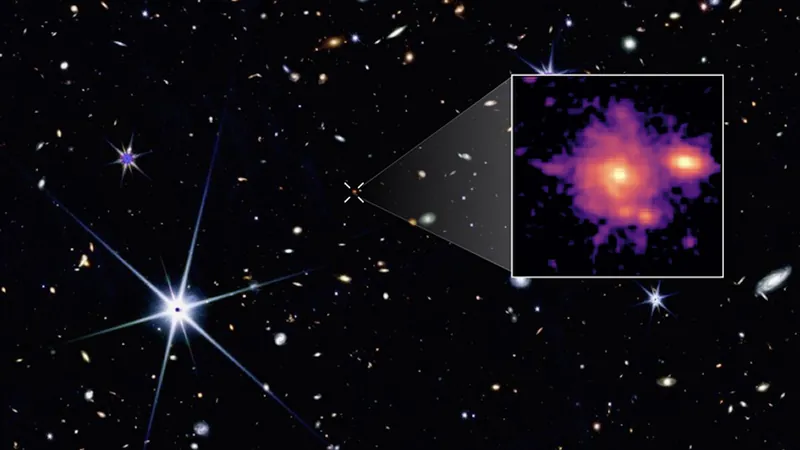
Astronomers Uncover Zhúlóng: The Most Distant Spiral Galaxy, Milky Way's Ancient Twin!
2025-04-16
Author: Li
A Revolutionary Discovery in the Cosmos!
The James Webb Space Telescope (JWST) has made waves in the astronomical community after unveiling a stunning discovery: a spiral galaxy that could be the Milky Way's long-lost sibling, swirling its arms back towards us from the depths of the early universe.
Introducing Zhúlóng: A Cosmic Look-Alike!
In breathtaking images capturing light emitted a mere 1 billion years after the Big Bang—when the universe was just 14% of its current age—this newly spotted galaxy, dubbed Zhúlóng, appears astonishingly complete. With its impressive bulge of aging stars and a vibrant disk filled with stellar newborns, Zhúlóng boasts two distinct spiral arms, establishing it as the most distant twin of our Milky Way ever identified.
Challenging the Norms of Cosmology
The existence of a fully formed galaxy so early raises eyebrows in the scientific community. Current cosmology theories suggest that large galaxies develop over billions of years through intricate mergers, making Zhúlóng's premature appearance a puzzle that defies existing expectations.
A Nod to Mythology: The Name Zhúlóng!
Named after a mythical Chinese sun dragon believed to control day and night, Zhúlóng's discovery was detailed in a study published on April 16 in the journal Astronomy & Astrophysics. Mengyuan Xiao, a postdoctoral researcher from the University of Geneva and lead author of the study, emphasized the striking resemblance Zhúlóng bears to our own galaxy in shape, size, and stellar mass.
A Cosmic Family Reunion!
Despite being an ancient sibling, Zhúlóng's dimensions are somewhat smaller—its star-forming disk stretches about 60,000 light-years, compared to the Milky Way's 100,000 light-years, and comprises around 100 billion solar masses against our galaxy's 1.5 trillion. Nevertheless, it stands out as the largest Milky Way look-alike observed from such an early epoch.
Accidental Discovery: The Power of PANORAMIC!
This incredible find arose from a fortuitous observation during PANORAMIC, a wide-field survey of billions of cosmic objects. By utilizing JWST's innovative 'pure parallel' mode, the telescope was able to observe two regions of space simultaneously, paving the way for such remarkable discoveries.
Deep-Space Mysteries Unveiled!
Zhúlóng’s unexpected existence contributes to a growing body of astronomical revelations suggesting that massive galaxies and supermassive black holes in the early universe developed at an astonishing rate— too fast to reconcile with current theories. While the Milky Way required billions of years to reach its size, Zhúlóng seems to have reached a comparable structure in under 1 billion years.
Future Observations Await!
To uncover more about this cosmic twin, researchers have proposed additional observations using both JWST and the Atacama Large Millimeter/submillimeter Array in Chile. As studies continue, Zhúlóng promises to offer profound insights into the mysteries of our universe and the formation of galaxies.
Stay Tuned for More Cosmic Discoveries!
Join us as we explore the depths of space! With the JWST transforming our understanding of the early universe, who knows what other secrets are yet to be revealed? The cosmos is calling!

 Brasil (PT)
Brasil (PT)
 Canada (EN)
Canada (EN)
 Chile (ES)
Chile (ES)
 Česko (CS)
Česko (CS)
 대한민국 (KO)
대한민국 (KO)
 España (ES)
España (ES)
 France (FR)
France (FR)
 Hong Kong (EN)
Hong Kong (EN)
 Italia (IT)
Italia (IT)
 日本 (JA)
日本 (JA)
 Magyarország (HU)
Magyarország (HU)
 Norge (NO)
Norge (NO)
 Polska (PL)
Polska (PL)
 Schweiz (DE)
Schweiz (DE)
 Singapore (EN)
Singapore (EN)
 Sverige (SV)
Sverige (SV)
 Suomi (FI)
Suomi (FI)
 Türkiye (TR)
Türkiye (TR)
 الإمارات العربية المتحدة (AR)
الإمارات العربية المتحدة (AR)